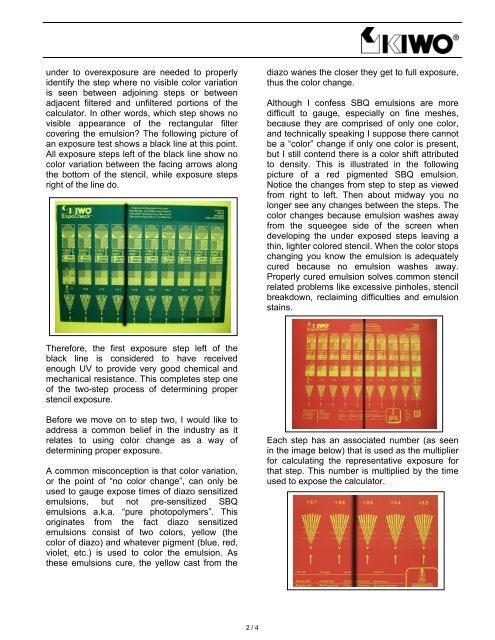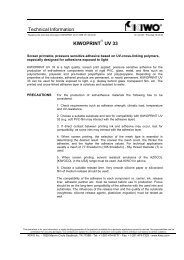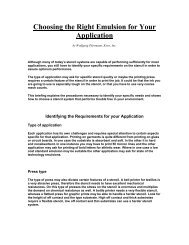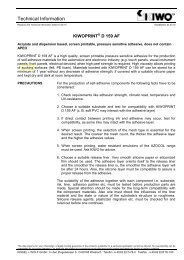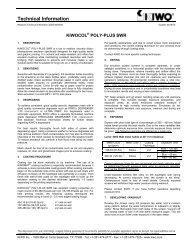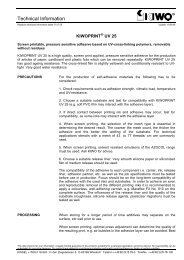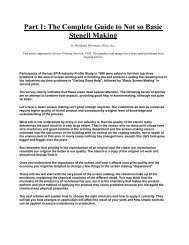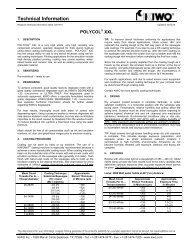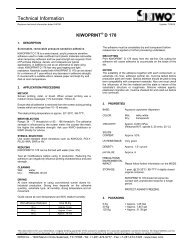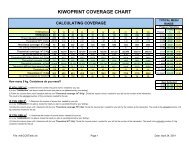Proper Exposure Calculation And the Compromise between ... - KIWO
Proper Exposure Calculation And the Compromise between ... - KIWO
Proper Exposure Calculation And the Compromise between ... - KIWO
You also want an ePaper? Increase the reach of your titles
YUMPU automatically turns print PDFs into web optimized ePapers that Google loves.
under to overexposure are needed to properly<br />
identify <strong>the</strong> step where no visible color variation<br />
is seen <strong>between</strong> adjoining steps or <strong>between</strong><br />
adjacent filtered and unfiltered portions of <strong>the</strong><br />
calculator. In o<strong>the</strong>r words, which step shows no<br />
visible appearance of <strong>the</strong> rectangular filter<br />
covering <strong>the</strong> emulsion The following picture of<br />
an exposure test shows a black line at this point.<br />
All exposure steps left of <strong>the</strong> black line show no<br />
color variation <strong>between</strong> <strong>the</strong> facing arrows along<br />
<strong>the</strong> bottom of <strong>the</strong> stencil, while exposure steps<br />
right of <strong>the</strong> line do.<br />
diazo wanes <strong>the</strong> closer <strong>the</strong>y get to full exposure,<br />
thus <strong>the</strong> color change.<br />
Although I confess SBQ emulsions are more<br />
difficult to gauge, especially on fine meshes,<br />
because <strong>the</strong>y are comprised of only one color,<br />
and technically speaking I suppose <strong>the</strong>re cannot<br />
be a “color” change if only one color is present,<br />
but I still contend <strong>the</strong>re is a color shift attributed<br />
to density. This is illustrated in <strong>the</strong> following<br />
picture of a red pigmented SBQ emulsion.<br />
Notice <strong>the</strong> changes from step to step as viewed<br />
from right to left. Then about midway you no<br />
longer see any changes <strong>between</strong> <strong>the</strong> steps. The<br />
color changes because emulsion washes away<br />
from <strong>the</strong> squeegee side of <strong>the</strong> screen when<br />
developing <strong>the</strong> under exposed steps leaving a<br />
thin, lighter colored stencil. When <strong>the</strong> color stops<br />
changing you know <strong>the</strong> emulsion is adequately<br />
cured because no emulsion washes away.<br />
<strong>Proper</strong>ly cured emulsion solves common stencil<br />
related problems like excessive pinholes, stencil<br />
breakdown, reclaiming difficulties and emulsion<br />
stains.<br />
Therefore, <strong>the</strong> first exposure step left of <strong>the</strong><br />
black line is considered to have received<br />
enough UV to provide very good chemical and<br />
mechanical resistance. This completes step one<br />
of <strong>the</strong> two-step process of determining proper<br />
stencil exposure.<br />
Before we move on to step two, I would like to<br />
address a common belief in <strong>the</strong> industry as it<br />
relates to using color change as a way of<br />
determining proper exposure.<br />
A common misconception is that color variation,<br />
or <strong>the</strong> point of “no color change”, can only be<br />
used to gauge expose times of diazo sensitized<br />
emulsions, but not pre-sensitized SBQ<br />
emulsions a.k.a. “pure photopolymers”. This<br />
originates from <strong>the</strong> fact diazo sensitized<br />
emulsions consist of two colors, yellow (<strong>the</strong><br />
color of diazo) and whatever pigment (blue, red,<br />
violet, etc.) is used to color <strong>the</strong> emulsion. As<br />
<strong>the</strong>se emulsions cure, <strong>the</strong> yellow cast from <strong>the</strong><br />
Each step has an associated number (as seen<br />
in <strong>the</strong> image below) that is used as <strong>the</strong> multiplier<br />
for calculating <strong>the</strong> representative exposure for<br />
that step. This number is multiplied by <strong>the</strong> time<br />
used to expose <strong>the</strong> calculator.<br />
2 / 4


